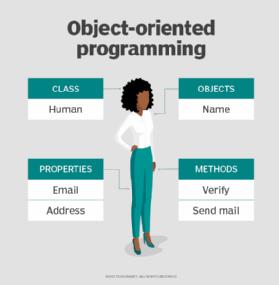Generationanddevelopmentdirection
Theobject-orientedlanguagedrawsontheartificialintelligencelanguageLISPinthe1950s,andintroducestheconceptofdynamicbindingandtheideaofaninteractivedevelopmentenvironment;since20ThediscreteeventsimulationlanguageSIMULA67inthe1960sintroducedtheessentialsandinheritanceofclassesandwasformedinSmalltalkinthe1970s.
Therearetwodirectionsinthedevelopmentofobject-orientedlanguages:oneispureobject-orientedlanguages,suchasSmalltalk,EIFFEL,etc.;theotherishybridobject-orientedlanguages,thatis,inprocedurallanguagesandotherlanguagesAddclasses,inheritanceandothercomponents,suchasC++,Objective-C,etc.
Mainfeatures
Object-orientedlanguagesdescribetheobjectivesystemmorenaturally,whichisconvenientforsoftwareexpansionandreuse.Therearefourmaincharacteristics:
(1)Recognizability,thebasiccomponentsinthesystemcanberecognizedasagroupofrecognizablediscreteobjects;
(2)Classification,systemAllobjectswiththesamedatastructureandbehaviorcanbegroupedintoonecategory;
(3)Polymorphism,theobjecthasauniquestatictypeandmultiplepossibledynamictypes;
(4)Inheritance,sharingdataandoperationsamongdifferentclassesofbasichierarchicalrelationships.
Amongthem,thefirstthreearethefoundation,andinheritanceisthecharacteristic.Thefour(andsometimesdynamicbinding)areusedincombinationtoreflecttheexpressiveabilityofobject-orientedlanguages.
Speciallanguage
Typical
Itisgenerallybelievedthatthemoretypicalobject-orientedlanguagesare:
simula67,whichsupportssingleinheritanceandcertainMeaningpolymorphismandpartialdynamicbinding;
Smalltalksupportssingleinheritance,polymorphismanddynamicbinding;
EIFFEL,supportsmultipleinheritance,polymorphismanddynamicbinding;
C++,supportsmultipleinheritance,polymorphismandpartialdynamicbinding.
Javasupportssingleinheritance,polymorphismandpartialdynamicbinding.
Althoughthemeaningsoftheconceptsinvolvedinthefivelanguagesarebasicallythesame,thetermsusedaredifferent.
C#,alsosupportssingleinheritance,hasmanysimilaritieswithJavaandC++,etc.
Class-based
Class-basedobject-orientedlanguagesareobject-orientedMainstreamintheworld.Itincludes:
Simula,thefirstobject-orientedlanguage
Smalltalk,thefirstlanguagetosupportdynamictyping
C++,mostofwhichisbasedonclassesThecharacteristicsofisinheritedfromSimula.etc.andsoon.
Thecounterpartofclass-basedlanguageisobject-basedobject-orientedlanguage.Theconceptof"object-based"hereisdifferentfromtheconceptofcallingVisualBasicobject-based."Object-based"herereferstoalanguagethatonlycentersonobjectsandhasnoconceptofclasses,similartolanguagessuchasPython.
Classesandobjects
Lookatthedefinitionofaclassfirst:
classcellis
varcontents:Integer:=0;
methodget():Integeris
returnself.contents;
end;
methodset(n:Integer)is
self.contents:=n;
end;
end;
AclassisusedtodescribeThecommonstructureofallobjectsbelongingtothisclass.Theobjectrepresentedbythiscellclasshasanintegerattributecalledcontents,whichisinitializedto0.Italsodescribestwomethodsofmanipulatingcontents.Getandset.Thecontentofthesetwomethodsareveryintuitive.TheSelfvariablerepresentstheobjectitself.
Thedynamicsemanticsofanobjectcanbeunderstoodasfollows:
Anobjectisinternallyrepresentedasapointertoasetofproperties.Anyoperationonthisobjectwillgothroughthepropertiesandmethodsofthispointeroperationobject.Whenanobjectisassignedorpassedasaparameter,allthatispassedisapointer,sothatthesamesetofpropertiescanbeshared.
(Note,somelanguages,suchasC++,clearlydistinguishthepointertotheattributegroupandtheattributegroupitself,whilesomeotherlanguageshidethisdifference)
TheobjectcanbenewInstantiatefromaclass.Tobeprecise,newCallocatesasetofattributesandreturnsapointertothissetofattributes.Thissetofattributesisgivenaninitialvalue,andincludesthecodeofthemethoddefinedbyclassC.
Let’sconsiderthetypebelow.ForanobjectgeneratedbynewC,recorditstypeasInstanceTypeOf(c).Anexampleis:
varmyCell:InstanceTypeOf(cell):=newcell;
Here,byintroducingInstanceTypeOf(cell),westarttodistinguishbetweenclassandtype.Youcanalsothinkofthecellitselfasatype,butthenyouwillfindthatdoingsowillcauseconfusion.
MethodAnalysis(MethodLookup)
Methodanalysisgivesamethodcallom(...),oneisTheprocesscalledmethodanalysisimplementedbyeachlanguageisresponsibleforfindingthecodeofthecorrectmethod.(Note:Didyouthinkofvtable?).
Intuitively,themethodcodecanbeembeddedineachindividualobject,andformanyobject-orientedlanguages,thesimilarsyntaxforpropertiesandmethodsdoesgivepeoplethisimpression.
However,consideringthespacesaving,fewlanguagesimplementthis.Themorecommonmethodisthatthelanguagegeneratesmanymethodsuites,andthesemethodsuitescanbesharedbyobjectsofthesameclass.Themethodresolutionprocesswillfollowthepointertothemethodsuiteintheobjecttofindthemethod.
Inconsiderationofinheritance,methodanalysiswillbemorecomplicated.Themethodsuitemaybecomposedofatree,andtheanalysisofamethodmayneedtofindaseriesofmethodsuites.Ifthereismultipleinheritance,themethodsuitemayevenformadirectedgraph,oraring.
Methodresolutionmayoccuratcompiletimeoratruntime.
Insomelanguages,thedetailsofwhetherthemethodisembeddedintheobjectorexistinthemethodsuiteareirrelevanttotheprogrammer.Becauseallthelanguagefeaturesthatcandistinguishthesetwomodesaregenerallynotsupportedinclass-basedobject-orientedlanguages.
Forexample,methodscannotbetakenfromobjectsandusedasfunctionslikeattributes.Methodscannotbeupdatedinobjectslikeattributes.(Thatis,themethodofanobjectisupdated,whilethemethodofotherobjectsofthesameclassremainsthesame.)
SubclassingandInheritance(SubclassingandInheritance)
Subclassesandinheritedsubclasses,likegeneralclasses,arealsousedtodescribethestructureofobjects.However,itachievesthisgoalincrementallybyinheritingthestructureofotherclasses.
Thepropertiesoftheparentclasswillbeimplicitlycopiedtothesubclass,andthesubclasscanalsoaddnewproperties.Insomelanguages,subclassescanevenoverridethepropertiesoftheparentclass(bychangingthetypeoftheproperty)
Methodsintheparentclasscanbecopiedtothesubclass,orcanbeoverriddenbythesubclass.
p>
Anexampleofsubclasscodeisasfollows:
subclassreCellofcellis
varbackup:Integer:=0;
overrideset(n:Integer)is
self.backup:=self.contents;
super.set(n);
end;
methodrestore()is
self.contents:=self.backup;
end;
end;
TherearesubclassesThemethodofparsingdiffersdependingonwhetherthelanguageisstaticallytypedordynamicallytyped.
Instaticallytypedlanguages(suchasC++,Java),thetopologicalstructureofthemethodsuiteoftheparentclassandthechildclassisdeterminedatcompiletime,sothemethodsinthemethodsuiteoftheparentclasscanbemergedGotothemethodsuiteofthesubclass,thereisnoneedtosearchthetreeorgraphofthismethodsuitewhenthemethodisanalyzed.(Press:C++vtableisthismethod)
Fordynamicallytypedlanguages,(thatis,therelationshipbetweenparentandchildclassesisdeterminedatruntime),themethodsuitecannotbemerged.Therefore,whenthemethodisanalyzed,itisnecessarytosearchalongthisdynamicallygeneratedtreeordirectedgraphuntilasuitablemethodisfound.Andifthelanguagesupportsmultipleinheritance,thissearchismorecomplicated.
Parentclassesandsubclasses
Fromtheaboveexamples,itseemsthatsubclassesareonlyusedtoborrowfromtheparentclassaSomedefinitionstoavoidduplication.However,whenconsideringsubsumption,thingsarealittledifferent.WhatisSubsumption?Pleaselookatthefollowingexample:
varmyCell:InstanceTypeOf(cell):=newcell;
varmyReCell:InstanceTypeOf(reCell):=newreCell;
proceduref(x:InstanceTypeOf(cell))is…end;
Lookatthefollowingcode:
myCell:=myReCell;
f(myReCell);
Inthesetwolinesofcode,thefirstonelineassignsonevariablesoftypeInstanceTypeOf(reCell)tooneAvariableofInstanceTypeOf(cell).Inthesecondline,avariableoftypeInstanceTypeOf(reCell)isusedasaparametertoafunctionwhoseparametertypeisInstanceTypeOf(cell).
ThisusageisillegalinlanguageslikePascal.Inobject-orientedlanguages,itiscompletelycorrectusageaccordingtothefollowingrules.Thisruleisusuallycalledsubtypepolimorphism,thatis,subtypepolymorphism(press:infact,subtypingshouldbethemostdifferentplaceinOOlanguagefromotherlanguages)
Ifc'isasubtypeofc,ando'Areoneinstancesofc',theno'isalsooneinstanceofc.
Strictlyspeaking:
Ifc'isasubclassofc,ando':InstanceTypeOf(c'),theno':InstanceTypeOf(c).
Carefullyanalyzetheaboverule,youcanintroduceasubtyperelationshipthatsatisfiesreflexivityandtransitivitybetweenthetypesofInstanceTypeOf,use
ThentheaboveThisrulecanbesplitintotworules:
1.Foranya:A,ifA
2.InstanceTypeOf(c’)
TheoneruleiscalledSubsumption.Itistheonlyonestandardforjudgingthesubtype(notethatitisasubtype,notasubclass).
Thesecondrulecanbecalledsubclassing-is-subtyping(subclassingissubtype,right?)
OneGenerallyspeaking,inheritanceTheyareallrelatedtosubclassing,sothisrulecanalsobecalled:inheritance-is-subtyping(inheritanceissubtyping)
Allobject-orientedlanguagessupportsubsumption(itcanbesaidthatifthereisnosubsumption,therewillbenoBecomeobject-oriented).
Mostclass-basedobject-orientedlanguagesdonotdistinguishbetweensubclassingandsubtyping.However,asomeofthelatestobject-orientedlanguageshaveadoptedamethodofseparatingsubtypingfromsubclassing..Inotherwords,AisasubclassofB,butobjectsofclassAcannotbeusedasobjectsofclassB.(Note:It'sabitlikeprivateinheritanceinC++,butthecontentisricherthanit)
Well,thedistinctionbetweensubclassingandsubtypingwillbediscussedlater.
Next,let’slookbackatthisprocedureagain.f.Inthecaseofsubsumption,whatisthedynamicsemanticsofthefollowingcode?
Proceduref(x:InstanceTypeOf(cell))is
x.set(3);
end;
f(myReCell);
WhenmyReCellispassedtofasanobjectofInstanceTypeOf(cell),whichoneversionofthesetmethodiscalledbyx.set(3)Woolencloth?IsitthesetdefinedinthecellortheonedefinedinthereCell?
Atthistime,therearetwooptions,
1.Staticdispatch(determinedaccordingtothetypeatcompiletime)
2.Dynamicdispatch(determinedaccordingtotherealtypeoftheobjectruntime)
(Press,friendswhoarefamiliarwithC++一willsmile,thiscouldn’tbeeasier.)
Thereisnothingtosayaboutstaticdispatch.
Dynamicdispatchhasoneinterestingproperties.Thatis,subsumptiononemustnotaffectthestateoftheobject.Ifthestateofthisobjectischangedduringsubsumption,suchasobjectslicinginC++,thedynamicanalysismethodmayfail.
Fortunately,thisattributeisverygoodforbothsemanticsandefficiency.
(Press,objectslicinginC++initializesthevptrofthenewobjecttoitsowntypeofvtablepointer,sothereisnoproblemofdynamicparsing.Butinfact,objectslicingcannotbecalledsubsumptionatall.
Inspecificlanguageimplementations,suchasC++,althoughsubsumptiondoesnotchangetheinternalstateoftheobject,thevalueofthepointermaychange.ThisisalsoaannoyingButtheC++vtablesolutioncanonlydothis.Thereareonevariantsofthevtablemethod,whichcanavoidpointerchangesandismoreefficient.Thismethodwillbeexplainedinanotherarticle.)
Abouttypeinformation
Althoughsubsumptiondoesnotchangethestateoftheobject,insomelanguages(suchasJava),Itdoesn'tevenhaveanyruntimeoverhead.However,itlostasomestatictypeinformation.
Forexample,thereisonetypeInstanceTypeOf(Object),andtherearenoattributesandmethodsdefinedintheObjectclass.ThereisanotheroneclassMyObject,whichinheritsfromObject.ThenwhentheobjectofMyObjectistreatedasInstanceTypeOf(Object)type,yougetauselessemptyobjectwithnothing.
Ofcourse,ifyouconsideralessextremecase,forexample,thereareamethodfdefinedintheObjectclass,andMyObjecthasamethodFisoverloaded,then,throughdynamicdispatch,thepropertiesandmethodsinMyObjectcanstillbemanipulatedindirectly.Thisisalsoatypicalmethodofobject-orienteddesignandprogramming.
Fromtheperspectiveofapurist,dynamicdispatchistheonlythingthatshouldbeusedtomanipulateattributesandmethodsthathavebeenforgottenbysubsumption.Itiselegant,safe,andallthegloryisattributedtodynamicdispatch!!!
However,whatdisappointspuristsisthatmostlanguagesstillprovideasomeofthepropertiesandmethodsthatareforgottenbythesubsumptionarecheckedatruntime.ThismethodisgenerallycalledRTTI(RunTimeTypeIdentification).Suchasdynamic_castinC++,orinstanceofinJava.
Tobehonest,RTTIisuseful.Butbecauseofasometheoreticalandmethodologicalreasons,itisconsideredtodestroythepurityofobject-oriented.
Firstofall,itbreakstheabstractionandmakesasomemethodsandpropertiesthatshouldn’tbeusedincorrectly.
Secondly,becauseoftheuncertaintyoftheruntimetype,iteffectivelymakestheprogrammorefragile.
Thethirdandperhapsthemostimportantonepoint,itmakestheprogramlackofscalability.Whenaddinganewtype,youmayneedtoreadthecodeofdynamic_castorinstanceofcarefullyandchangethemifnecessarytoensurethattheadditionofthisnewtypewillnotcauseproblems.
ManypeopleonementionedRTTI,alwaysfocusingonitsruntimeoverhead.However,comparedtothemethodologicalshortcomings,thisruntimeoverheadisreallyinsignificant.
Intheframeworkofpurist(press,takeabreath,lookintothedistance,doadeeplook),theadditionofnewsubclassesdoesnotneedtochangetheexistingcode.
Thisisaverygoodadvantage,especiallywhenyoudon’thaveallthesourcecode.
Ingeneral,althoughRTTI(alsocalledtypecase)seemstobeaninevitableafeature,itisbecauseofitsmethodologicalaSomedisadvantages,itmustbeusedverycarefully.Manythingsinthetypesystemofobject-orientedlanguagestodayaretheresultofvariouseffortstoavoidRTTI.
Forexample,insomecomplextypesystems,youcanusetheSelftypeonparametersandreturnvaluestoavoidRTTI.Thiswillbeintroducedlater.
Covarance,ContravarianceandInvariance(Covarance,ContravarianceandInvariance)
Inthefollowingsections,wewillintroduceOnetypetechniquetoavoidRTTI.Beforethat,let’sfirstintroducetheconceptsof"covariance","anti-covariance"and"alwaysunchanged".
Covariance
First,let’slookattheonepairtype:A*B
ThistypesupportsoneAgetA()operationtoreturntheAelementinthisPair.
GivenoneA’
Why?ItcanbeprovedbytheattributeofSubsumption:
AssumingthereareoneobjectsoftypeA'*Ba'*b,here,a':A',b:B,a'*b
Then,because,A'
Inthisway,thetypeA*BisdefinedascovariantforA.
Similarly,itcanalsobeprovedthatA*BisalsocovarianttoB.
Regularapoint,Covarianceisdefinedasfollows:
GivenL(T),here,typeLiscomposedoftypeT.So,
IfT1
anti-covariance

pleaseseeafunction:Af(Bb);(usingthedefinitionoffunctionallanguagePerhapsmoreconcise,thatis,f:B->A)
Then,givenone,whatkindofsubtypeisbetweenB'AandB'->AWhatabouttherelationship?
ItcanbeprovedthatB->AA.
Basedonspace,noderivationwillbemade.
So,theparametertypeofthefunctionisanti-covariant.
ThedefinitionoftheregularpointofContravarianceisasfollows:
GivenL(T),here,thetypeLiscombinedbythetypeT.Then,
IfT1
thesame,itcanbeprovedthatthereturntypeofthefunctioniscovariant.
Itdoesn’tchangeatall.
Thenconsiderthefunctiong:A->A
Here,AappearsbothinthepositionoftheparameterandinthereturnThepositioncanprovethatitisneithercovariantnoranti-covariant.
Forthissituationthatisneithercovariantnoranti-covariant,itiscalledInvariance
ItisworthnotingthatforthefirstfirstThePairtypeinthisexample,ifsetA(A)issupported,thenPairbecomesInvariance.
MethodSpecialization
Inthepreviousdiscussionofsubclasses,thesimplestmethodisoneTheruleofoverride,thatis,theoverridemethodmusthavethesamesignatureastheoverridemethod.
However,fromtheperspectiveoftypesafety,thisisnotnecessary.
Inthisway,aslongasA
classcis
methodm(x:A):Bis…end;
methodm1(x1:A1):B1is…end;
end;
subclassc'ofcis.
Differentiationmethod
TraditionalOneofthemainfeaturesofclass-basedobject-orientedlanguagesistheinseparableconnectionbetweeninheritance,subclassingandsubtyping.Manyobject-orientedlanguagegrammarsandconceptscomefromthesethree.Forexample,throughsubclassing,youcaninheritsomemethodsoftheparentclass,whileatthesametimeyoucanrewritethemethodsoftheparentclassinthesubclass.Thisrewrittenmethodcanbecalledfromaobjectwhosetypeistheparentclassthroughsubtypingandsubsumption.
However,inheritance,subclassing,andsubtypingdonotalwaysliveinharmony.Ononesomeoccasions,theentanglementbetweenthethreewillhindercodereusethroughinheritanceorgenerics.Therefore,peoplebegantonoticethepossibilityofseparatingthesethree.Itiscommontodistinguishbetweensubclassingandsubtyping.Otheramethodsarestillintheresearchstage.
Objecttype
Inearlyobject-orientedlanguages(suchasSimula),thedefinitionofthetypeandtheimplementationofthemethodaremixedinaStarted.Thisapproachviolatestheprincipleofseparatingimplementationandspecificationthatiswidelyrecognizedtoday.Thisseparationprincipleisespeciallyimportantwhendevelopmentiscarriedoutbyateam.
Morealanguage,distinguishbetweenimplementationandspecificationbyintroducingobjecttypesthatdonotdependonimplementation.Modula-3andotherlanguagesthatsupportclassandinterfacesuchasJavausethistechnology.
WhenInstanceTypeOf(cell)wasfirstintroduced,theconceptitrepresentedwasquitelimited.Itseemsthatitonlyrepresentsthetypeofobjectsgeneratedbynewcell,soitcannotbeusedtorepresentobjectsfromothertypesofnew.Butlater,whentheintroductionofsubclassing,methodoverriding,subsumptionanddynamicdispatch,thingsbecamelesssimple.TheInstanceTypeOf(cell)canalreadybeusedtorepresentobjectsderivedfromthesubclassofcell.Theseobjectscanincludeattributesandmethodsthatarenotdefinedbythecellclass.
ItseemsunreasonabletoletInstanceTypeOf(cell)dependonaspecificclass.Infact,oneobjectoftypeInstanceTypeOf(cell)doesnotnecessarilyonehaveanythingtodowithclasscell.
Theonlyonebetweenitandthecellclassisthatithasthesignatureofallthemethodsdefinedbythecellclass.
BasedonthisConsider,youcanintroducethesyntaxoftheobjecttype:
ForthedefinitionofthecellclassandthereCellclass:
classcellis
varcontents:Integer:=0;
methodget():Integeris
returnself.contents;
end;
methodset(n:Integer)is
self.contents:=n;
end;
end;
subclassreCellofcellis
varbackup:Integer:=0;
overrideset(n:Integer)is
self.backup:=self.contents;
super.set(n);
end;
methodrestore()is
self.contents:=self.backup;
end;
end;
Youcangivesuchanobjecttypedefinition:
ObjectTypeCellis
varcontents:Integer;
methodget():Integer;
methodset(n:Integer);
end;
ObjectTypeReCellis
varcontents:Integer;
varbackup:Integer;
methodget():Integer
methodset(n:Integer);
methodrestore();
end;
ThedefinitionofthesetwotypesincludesthetypesofattributesandmethodsdefinedbyallcellandreCellclasses,buttheyarenotDoesnotincluderealization.Inthisway,theycanbeusedasinterfacesthathavenothingtodowithimplementationdetailstoachievetheseparationofspecificationandimplementation.Twocompletelyunrelatedclassescandc'canhavethesametypeCell,andusersoftheCelltypedonotneedtocarewhetheritusesclasscorclassc'.
Notethatyoucanalsoaddadditionalinheritance-likesyntaxtoavoidrewritingthemethodsignatureinCellinReCell.Butthat'sjustasmallsection.
Separation
Intheabovediscussion,therelationshipbetweensubtypesisbasedontherelationshipbetweensubclasses.Butifyouwanttomakethetypeindependentoftheclass,youalsoneedtodefineasubtypethatisindependentofthesubclass.
Whendefiningthesubtype,youarefacedwithseveralchoices:Isthesubtypedeterminedbythecompositionstructureofthetype?Orisitdeterminedbythename?
Thesubtypedeterminedbythecompositionstructureofthetypeislikethis:Ifthetypeahasalltheattributesandmethodsthatthetypetwoneedstohave,thenthetypeoneisthesubtypeoftypetwo.
Thesubtypedeterminedbythetypenameislikethis:onlywhenthetypeahasalltheattributesandmethodsrequiredfortypetwo,Andonlywhenthetype1isclearlydeclaredasasubtypeoftype2,thisrelationshipisrecognized.
Andifthechoiceisone,thenthoseattributesandmethodsarenecessaryforsubtype?Whichonesaredispensable?
Thesubtypedeterminedbythecompositionstructurecanbetype-matchedinthedistributedenvironmentandtheobjectpersistencesystem.Thedisadvantageisthatifthetwotypeshappentohavethesamestructure,butinfacttheyareirrelevant,itwillcauseerrors.However,thiskindoferrorcanbeavoidedwithsometechniques.
Incontrast,name-basedsubtypesarenoteasytoaccuratelydefine,andstructure-basedsubtypesarenotsupported.
YoucandefineasimpleThestructure-basedsubtyperelationship:
ForthetwotypesOandO',
O'
Forexample:ReCell
Forthesakeofsimplicity,thisdefinitiondoesnottakeintoaccountthemethodSpecialization.
Inaddition,whenthetypedefinitionhasrecursion(similartothedefinitionofalinkedlist),thedefinitionofsubtypeneedstobeextracareful.
Becausewedon’tcareabouttheorderofmembers,thissubtypedefinitionautomaticallysupportsmultiplesubtypes.
Forexample:
ObjectTypeReIntegeris
varcontents:Integer;
varbackup:Integer;
methodrestore();
end;
Then,Thereisthefollowingsubtyperelationship:
ReCell
ReCell
(Press,theexampledoesnottakeintoaccountdetailssuchastheinterfacecannotcontainthedatafield.Infact,ifyousupportthedatafieldOverrideinsteadofshadowing-theauthor'sstructure-basedsubtypesemanticsdoesimplysuchlogic-then,itdoesnotmatterwhetherthedatafieldisincludedintheinterface,becausethetroublesomenameconflictproblemnolongerexists)
Fromthisdefinition,wecanconclude:
Ifc'isasubclassofc,thenObjectTypeOf(c')
Notethattheinversepropositionofthisdefinitiondoesnothold,Thatistosay:
Evenifthereisnosubclassrelationshipbetweenc'andc,aslongasthemembersdefinedbythemconformtothedefinitionofsubtype,ObjectTypeOf(c')
LookbackandlookatThesubclass-is-subtypingofthepreviousface:
InstanceTypeOf(c')
Incontrast,subclassingandsubtypinghavebeenpartiallyseparated.Subclassingisstillsubtyping,butsubtypingnolongerrequiressubclassing.
Thispropertyiscalled"subclassing-implies-subtyping"insteadof"subclass-is-subtyping".
Generic
TypeParameters
OneGeneralmeaningIntheabove,genericsareatechnologythatreusesthesamecodeondifferenttypes.Asaatechnologyrelativelyindependentofotherobject-orientedfeatures,ithasbecomemoreandmorecommoninobject-orientedlanguages.Thereasonwhygenericsarediscussedhereisonebecausethetechnologyofgenericsisveryinterestinginitself,andalsobecausegenericsareoneusedtodealwithThemaintoolforbinarymethodproblems.
Usedtogetherwithsubtyping,genericscanbeusedtosolveasomeofthedifficultiesofthetypesystemcausedbyanti-covarianceinmethodssuchasmethodspecialization.Considerthisaexample:
TherearetwotypesofPersonandVegetarian,andatthesametime,therearetwotypesofVegitableandFood.Moreover,Vegitable
ObjectTypePersonis
…
methodeat(food:Food);
end;
ObjectTypeVegetarianis
…
methodeat(food:Vegitable);
end;
Here,fromcommonsense,IknowoneAVegitarianisaaindividual.Therefore,IhopetherecanbeaVegetarian
.Unfortunately,becausetheparametersareanti-covariant,ifyoumistakenlythinkthatVegetarianisaVegetarianobject,itcanbeusedasaPerson.Soonevegetariancaneatmeatbymistake.
Usinggenerictechnology,introducingTypeOperator(thatis,derivingfromonetypetoanotheronetype,conceptuallysimilartothetypefunction).
ObjectOperatorPersonEating[F
…
methodeat(food:F);
end;
ObjectOperatorVegetarianEating[F
…
methodeat(food:F);
end;
ThetechniqueusedhereiscalledBoundedTypeParameterization.(Trelli/Owl,Sather,Eiffel,PolyTOIL,RaptideandGenericJavaallsupportBoundedTypeParameterization.Otherlanguages,suchasC++,onlysupportsimplegenericswithouttypeconstraints)
Fisone
b>Atypeparameter,whichcanbeinstantiatedintoaspecifictype.Similartothetypedefinitionofvariables,aboundisalegaltypesuchasF.ThetypeVegetarianEating[Vegitable]isainstanceofVegetarianEating,anditisequivalenttothetypeVegan.(Usingastructure-basedsubtype)
So,thereare:
ForanyF
FortheoriginalVegetariantype,thereare:
Vegetarian=VegetarianEating[Vegetable]
Thisrelationshipcorrectlyexpresses"一Avegetarianistheconceptof"apersonwhoeatsvegetables".
InadditiontoBoundedTypeParameterization,thereareasimilarmethodsthatcanalsosolvethisvegetarian’sproblem.Thismethodiscalled:BoundedAbstractType.Pleaseseethisdefinition:
ObjectTypePersonis
TypeF
…
varlunch:F;
methodeat(food:F);
end;
ObjectTypeVegetarianis
TypeF
…
varlunch:F;
methodeat(food:F);
end;
Here,FisaPersonwhoknowshecaneatcertainKindofFood,butIdon’tknowwhichkindofone.TheattributeofthislunchprovidestheFoodthatthePersoneats.
WhencreatingthePersonobject,youcanfirstselectaFoodsubtype,forexample,F=Dessert.Then,UseonevariableofDesserttypetoassigntotheattributelunch.Finally,implementoneeat(food:Dessert)method.
Inthisway,whenaVegetarianistreatedasaaPerson,thisVegetariancansafelyeathisownlunch,evenifhedoesnotknowwhetherheiseatingmeatorvegetables.
ThelimitationofthismethodisthatPersonandVegancanonlyeattheirownlunch.Can'tletthemeatlunchtheybought.
p>